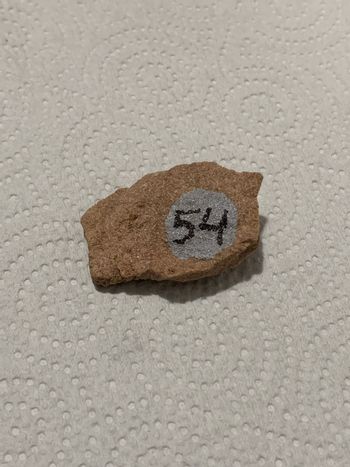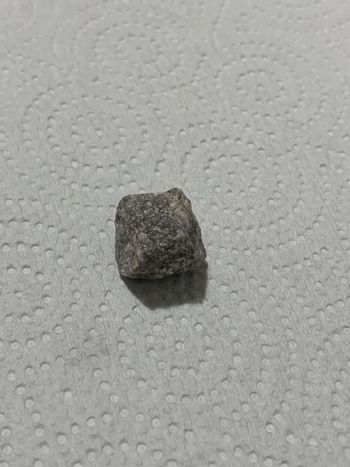
This is Geology!
Please help me identify the Sedimentry rocks samples below by answer the following questions:
1. Color(s)
2. Texture & Clast Description (grain size, shape, sorting, etc.)
3. Rock Type (clastic, chemical, organic etc.)
SEDIMENTARY ROCK TYPES:
Clastic – Clastic or detrital sedimentary rocks form when bits and pieces of other rocks and minerals are compressed and cemented together so that they form a new, solid rock. An example of a clastic rock that you might be familiar with is sandstone, where bits and pieces of sand have been cemented together.
Chemical – Chemical sedimentary rocks form when elements that were dissolved in water are able to crystalize. This can happen via evaporation (example: on a salt flat in the desert) where the water is evaporated but the dissolved elements are left behind, or in a body of water when the right temperatures and pressures are reached to cause crystals to form. An example of a rock forming via crystallization in a body of water would be limestone that forms on the ocean floor.
Organic – Organic sedimentary rocks form due to an organism that produces them. This usually happens in the oceans, but can also happen on land in swamps or lakes. Coal in a perfect example of an organic sedimentary rock because the plants die and their remains eventually become coal.
Biochemical – Biochemical sedimentary rocks form by a combination of chemical and organic processes.
Remember that sedimentary rocks are classified using their SEDIMENT SIZE and COMPOSTION.
SEDIMENT SIZE: sizes range from large to not visible
CLASTIC ROCK TEXTURES: sorting, sphericity, and rounding


PICTURE A
Sandstone is a clastic sedimentary rock composed mainly of sand-sized (0.0625 to 2 mm) silicate grains. Sandstones comprise about 20–25% of all sedimentary rocks
Sandstones are composed of particles with an average size of between 2.00 and 0.0625 mm in diameter
sandstones usually have a rough, granular texture, but to really identify a sandstone you have to peer closely at its surface and look for individual sand grains.
Sandstones are made of sand grains that have been cemented together
colors are tan, brown,
Step by stepSolved in 2 steps

 Applications and Investigations in Earth Science ...Earth ScienceISBN:9780134746241Author:Edward J. Tarbuck, Frederick K. Lutgens, Dennis G. TasaPublisher:PEARSON
Applications and Investigations in Earth Science ...Earth ScienceISBN:9780134746241Author:Edward J. Tarbuck, Frederick K. Lutgens, Dennis G. TasaPublisher:PEARSON Exercises for Weather & Climate (9th Edition)Earth ScienceISBN:9780134041360Author:Greg CarbonePublisher:PEARSON
Exercises for Weather & Climate (9th Edition)Earth ScienceISBN:9780134041360Author:Greg CarbonePublisher:PEARSON Environmental ScienceEarth ScienceISBN:9781260153125Author:William P Cunningham Prof., Mary Ann Cunningham ProfessorPublisher:McGraw-Hill Education
Environmental ScienceEarth ScienceISBN:9781260153125Author:William P Cunningham Prof., Mary Ann Cunningham ProfessorPublisher:McGraw-Hill Education Earth Science (15th Edition)Earth ScienceISBN:9780134543536Author:Edward J. Tarbuck, Frederick K. Lutgens, Dennis G. TasaPublisher:PEARSON
Earth Science (15th Edition)Earth ScienceISBN:9780134543536Author:Edward J. Tarbuck, Frederick K. Lutgens, Dennis G. TasaPublisher:PEARSON Environmental Science (MindTap Course List)Earth ScienceISBN:9781337569613Author:G. Tyler Miller, Scott SpoolmanPublisher:Cengage Learning
Environmental Science (MindTap Course List)Earth ScienceISBN:9781337569613Author:G. Tyler Miller, Scott SpoolmanPublisher:Cengage Learning Physical GeologyEarth ScienceISBN:9781259916823Author:Plummer, Charles C., CARLSON, Diane H., Hammersley, LisaPublisher:Mcgraw-hill Education,
Physical GeologyEarth ScienceISBN:9781259916823Author:Plummer, Charles C., CARLSON, Diane H., Hammersley, LisaPublisher:Mcgraw-hill Education,





